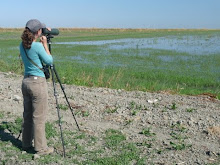The 8th Neotropical Ornithological Congress had been going on for three days... We were mainly confined to the grounds of the hotel and beginning to feel a little claustrophobic. The conference planners sensed this potential for restlessness and planned a fantastic field trip experience for mid-week. I embarked on a full day trip to the Cueva de Guacharo and surrounding mountains for birding extraordinare!
We left the hotel at 5 A.M. (Planned departure was for 4:30 am but remember nothing happens on time here:). We stopped at one wetland area where we saw water tyrants, neotropical cormorants and striated herons and then were off for the highlight of the day, to see Guacharos, an endemic night bird also known as the oilbird.

Guacharos live in caves throughout the Guacharao National Park in northeastern Venezuela. They are a strictly nocturnal bird, exiting the cave at dusk in search of fruit, their main diet. There is one cave that is open to the public. The cave is ginormous (gigantic and enormous) and over 10 kms long. Guided by the light of gas lanterns used by the park rangers, we could only walk in ~1200m but the experience is nothing that can described in words. Huge stalactites and stalagmites and the cacophony of the Guacharo calls to from their roosts on the walls of the cave accompanied us on our walk until we entered the Cuadro de Silencio (silence room) reached through a narrow entrance too small for the Guacharos to navigate. In addition to a loud, low squawk the Guacharos also use a type of eco-location, though much slower than a bats, to navigate in the blackness of the cave.

A truly amazing experience.
 Guacharos live in caves throughout the Guacharao National Park in northeastern Venezuela. They are a strictly nocturnal bird, exiting the cave at dusk in search of fruit, their main diet. There is one cave that is open to the public. The cave is ginormous (gigantic and enormous) and over 10 kms long. Guided by the light of gas lanterns used by the park rangers, we could only walk in ~1200m but the experience is nothing that can described in words. Huge stalactites and stalagmites and the cacophony of the Guacharo calls to from their roosts on the walls of the cave accompanied us on our walk until we entered the Cuadro de Silencio (silence room) reached through a narrow entrance too small for the Guacharos to navigate. In addition to a loud, low squawk the Guacharos also use a type of eco-location, though much slower than a bats, to navigate in the blackness of the cave.
Guacharos live in caves throughout the Guacharao National Park in northeastern Venezuela. They are a strictly nocturnal bird, exiting the cave at dusk in search of fruit, their main diet. There is one cave that is open to the public. The cave is ginormous (gigantic and enormous) and over 10 kms long. Guided by the light of gas lanterns used by the park rangers, we could only walk in ~1200m but the experience is nothing that can described in words. Huge stalactites and stalagmites and the cacophony of the Guacharo calls to from their roosts on the walls of the cave accompanied us on our walk until we entered the Cuadro de Silencio (silence room) reached through a narrow entrance too small for the Guacharos to navigate. In addition to a loud, low squawk the Guacharos also use a type of eco-location, though much slower than a bats, to navigate in the blackness of the cave.
 A truly amazing experience.
A truly amazing experience.
